The Pyrenees by Default
The Pyrenees
by Default
But with no regrets!
by Arne Nilsson
Back in February, when winter was still having a strong grip on Sweden, Morgan and I planned for a week of railbiking in May. Looking forward to this trip helped me survive an unusually cold winter. Our idea was to drive to Poland and the neighboring Eastern Germany (formerly communist GDR). We assumed then (and still do) that there must be lots of rusty rail in this area, since the Communists kept everything running, while the Capitalists now in charge, increasingly look at the profitability of each line.
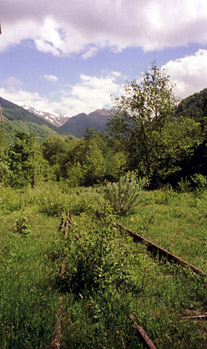
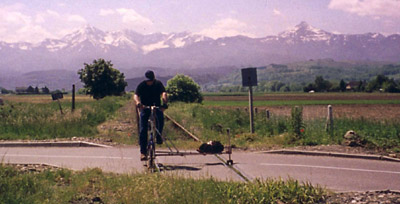
However, we never got to Poland. It so happened that my brother read in a French magazine about the closure of a 200-mile line from Spain over the Pyrenees into France. We knew that the French part had been closed for some 25 years and probably would be very overgrown, but taking the opportunity to ride
Top: Morgan on the line in Southern France with the Pyrenees in the background. Above: Another section of the French line which was heavily overgrown.
the Spanish side seemed like a must, now that this section was closed. From the magazine it was unclear whether the closure was temporary or permanent. Plans were quickly changed in favor of Spain, which by the way is a very nice country to visit with or without railbikes.
As always, plans were made with sunshine in mind. We landed in Barcelona just a few hours before a rainstorm was due. Time to change plans again. We decided to drive across Spain to south eastern Portugal where we knew there were tracks and the weather forecast was good. A railbiker must be prepared for long drives. We scouted for and found an abandoned line on the way, but in doing so, the rental car almost got stuck in the red clay. Roads are more dangerous than abandoned track.
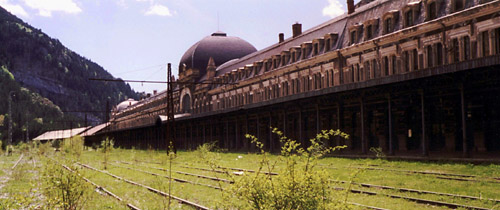
This very impressive station is in Confrance in the Pyrenees. The photo shows the French side.
After a few days, the rainstorm left northern Spain, and we again checked the line we had come to Spain to ride in the first place. Would it be closed or in use? The closer we got the more exciting it became, but to our disappointment the line had been repaired and reopened again with two daily passenger trains going up to the summit town of Constance. Since Spain has a wider track gauge than France passengers had to change trains here. To accommodate a speedy transfer the Spanish built a giant station. The French trains would stop on one side of a building and the Spanish trains would wait on the other side. In the building there were some 20 to 30 customs desks, each servicing half a car. The top floor housed all the needed custom clerks and supervisors. Quite an operation. This unbelievable palace-like building really looks out of place where it sits high in the mountains. Today it is abandoned and slowly deteriorating.
We noticed that the rail tunnel was being converted to an escape for the adjacent road tunnel, so there will never be any more trains into France. On the French side nature was much greener, and we found the rails far too overgrown to be passable. The grade was steeper than on the Spanish side. The railroad followed the road down the Pyrenees, towards the town of Oloron which now is the end station for trains. We found a section in Oloron that was clear of vegetation, so we rode on it partly through town, which always is nice.
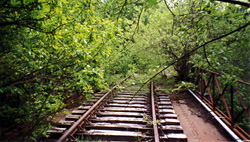
The line on the French side was impossible to ride.
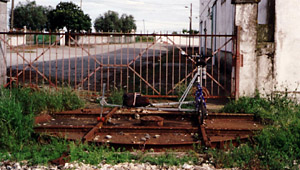
The smallest turntable I have ever seen, just large enough for a railbike!
It was time to change plans again, where would we go now to find track? We decided to check out some lines in France that ran up into the foothills of the Pyrenees. On the map there were about five of them, and if only one was OK we would be happy. This time we had luck. The first one we checked was perfect, deep rust on the rails and no vegetation. It gave us a full day's ride. The next day we had to drive back to Barcelona and on the way found another recently closed line of some fifty miles.
Once back aboard the plane home, we concluded that after all we had had a great week of railbiking, although none of it in Spain. I recall once reading that a plan more often is an instrument to facilitate change, than something to be followed. By the way my brother and I are now planning a trip in May to the Czech Republic or Italy.
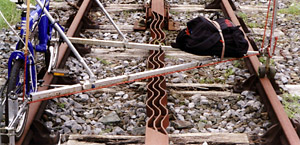
A French speciality found on many old rail lines.
I challenge you to figure out what it is.

Correctly answer Arne's question in the photo caption to the right and win a free subscription to the Insider.
Once in Portugal we got our bikes out and tried a section of a long line we hadn't been on before. People told us there were plans to start a tourist train here, so next time it might not be available. This part of Portugal has large very old plantations of cork oak, which are truly serene and almost paradise-like. The law protects them and railbiking is the only way I know to get into the area since it is on private land. I have never seen a hiker in there. However one may see small herds of black pigs living on acorns, or bigger herds of sheep grazing the grass in the sparse forest. A shepherd and his dog always accompany the sheep, while the pigs seem to manage alone. By the way, these forests are threatened now that more and more plastic is taking the place of cork in wine bottles. I am happy to have discovered this area before it is cut and replaced by wheat fields, which is what the landowners want to do.